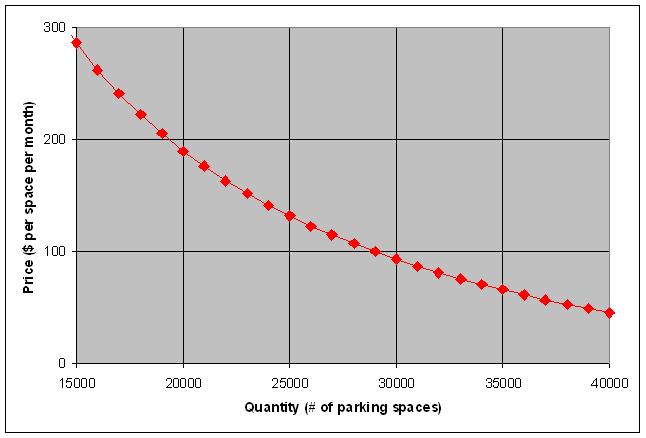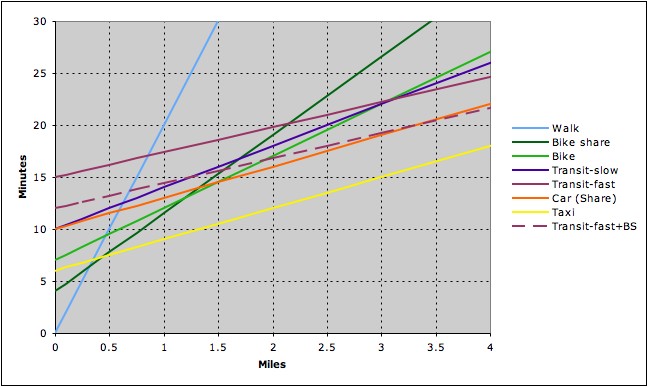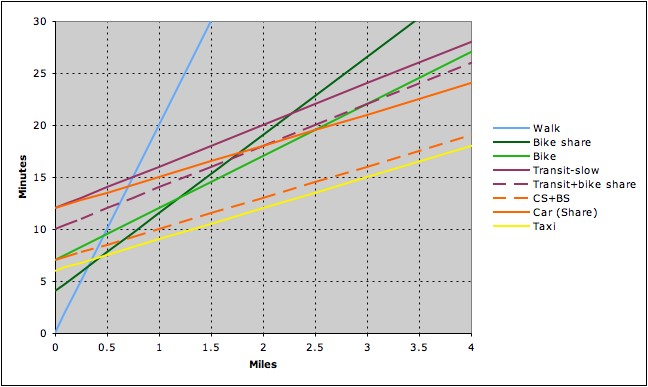… and how much will it cost?
When Minneapolis put in to place “winter parking restrictions” this week (as we discussed earlier), how many parking spaces disappeared in to thin air (or in to a snow bank as the case may be)? It’s not hard to get a rough estimate. But first, which neighborhoods will be most affected? Downtown won’t be, since it has almost no street parking and every road is a snow emergency route (only non-emergency routes are subject to the parking ban). Many areas of the city have ample off-street parking and/or ample on-street parking, generally due to low population densities but, in some cases, due to low rates of car ownership, so parking will not be a major issue there. This leaves high-density areas with relatively high levels of car ownership as the main locations where parking is going to be come nightmarish:
- The quadrangle between Loring Park and 36th Street S and I-35W and the Lakes
- The West Bank of the U of M (north of Franklin, east of Hiawatha)
- The area along University Avenue on the East Bank
Obviously, the first area is far and away larger than the others, and it has many more non-snow emergency residential streets which are impacted by the parking rules. Home to many pre-war apartment complexes with little or no off-street parking, it is already the hardest residential area of the city to find parking. And it’s about to get harder. But by how much?
Looking at satellite photos on Google maps, it’s relatively easy to get a rough estimate of the number of parking spaces. For every north-south block (the long block in Minneapolis, with eight blocks to a mile) there are approximately 25 on-street parking spaces on each side of the street. Each east-west block, which are half as long, have about 10 spaces (most have an alley in the middle, and because of the alleys, there are few driveways in this section of the city). So for every non-emergency block, there are 70 parking spaces. 35 are gone for the next two months.
But every block is not a non-snow emergency route. Many main streets in Minneapolis are designated as snow emergency routes: pretty much any street which is a one-way, any street which carries a bus line, and many others (see a map, a large .pdf). This means that between Franklin and 36th, half of the east-west streets are snow emergency routes. And about a third of north-south streets are. But once we take a look at the map, we can pretty easily count the blocks, multiply, and have a good idea at the number of lost street parking spaces.
East-west streets: 120 blocks * 10 spots per block = 1200 parking spaces
North-south streets: 170 blocks * 25 spots per block = 4250 parking spaces
For a total of 5450 parking spaces.
Without a GIS at my fingertips, I can’t quickly calculate the population of these neighborhoods, but the location we are talking about fits in rather well to several Minneapolis neighborhoods: Lowry Hill (3,999), Lowry Hill East (5,912), East Isles (3,340), ECCO (2,545), CARAG (5,907), Lyndale (7,690), Whittier (15,455), Stevens Square/Loring Heights (3,948) and Loring Park (7,501). In these approximately four square miles reside nearly 60,000 people, with a population density of more than 14000—a density similar to Chicago and Boston, which are not easy places to park. It also means that for every ten residents a parking space is disappearing.
How does this number stack up to the total number of spaces in the area? A very rough estimate would be that there are approximately 20,000 on-street parking spaces (which are not time-restricted or metered) in the entire aforementioned area, or one for every three residents. And approximately 5000 will be removed.
This is actually something we can use elementary economics to try to figure out. Once parking reaches a certain level of utilization—once you can’t expect to easily find a convenient space—it becomes a market. Basically, if you need parking, you’ll either pay for an off-street space, or there is a opportunity-cost to finding an on-street space. If you need to find parking every day, it might mean spending five minutes circling the block and then walking five minutes each way to the space—at a time valuation of $12 per hour, that’s a cost of $3 per day, or $75 to $100 per month, which is generally what a parking space will cost in a neighborhood without ample street parking. (But also without exorbitant property values; a parking space costs, per square foot, about as much as living space. In this section of Minneapolis, housing costs around one dollar per square foot per month, so a 100 square foot parking space would cost about $100 per month. In other cities, where housing is more expensive, so is parking.)
Let’s consider that the average utilization of the on-street parking is above 90%—about one free spot, on average, per block. That means that at any given time, there is a “market” for at least 18,000 free parking spaces in this area of Minneapolis. If we assume that this market is in equilibrium (There’s no reason we shouldn’t. People who have cars pay the ~$100 per month it costs to park, whether it is included in their rent, in a spot they pay for separately or in the opportunity of finding street parking. Those without have decided to take the money they save on parking, and other facets of car ownership, and put it towards transit, walking, bicycling and others uses.), there is currently a surplus of 2000 parking spaces.
Now, parking supply is not perfectly inelastic, but it’s close. The only way to increase the supply of parking is for people with existing spaces to rent their spots on Craigslist (a common practice in Boston and San Francisco, but less so in Minneapolis); there are few major parking lots in the area. But if we consider that the market for spaces is rather maxed out, that’s a relatively small market, and there are significant barriers to entry and difficulties in marketing; plus, it’s barely worth the time to rent out a space for a couple of months and a couple hundred bucks. The other way to increase the supply of parking would be to increase the utilization of existing spaces, but even if you were to raise the utilization to 100%, it would only add 2000 spots to the mix. And utilization will never reach 100% as the market is not perfectly dispersed—the opportunity cost of walking a mile each way to a parking space is far higher than the cost of circling the block a few more times.
So parking has a vertical supply curve, or something close to it, as it has, for most intensive purposes, inelastic supply. (The example given for inelastic supply is the supply of land, and that’s basically what parking is.) So, when the supply is shifted downwards, the quantity can not change; only the price can. And as far as demand—in the long run, demand is elastic. If you added 5000 parking spaces, more people would have cars, and if you made the parking changes permanent, people aggravated with parking would sell their cars. But in the space of two months, few people will have the opportunity to make these changes. So demand is elastic in the short run, and inelastic in the long run.
Now, back to our assumptions of 20,000 parking spaces decreasing to 15,000. How much is this going to cost Minneapolis parkers? Well, we first need a couple assumptions. Let’s assume the current cost of a parking space, at 20,000 spaces, is $90 per month. And let’s assume that as parking becomes scarcer, the overall amount paid for parking goes up, by $100,000 for every 1000 spaces lost. To make sense of this second variable, we can convert these numbers in to time costs. $90 a month equals 15 minutes a day, with 10,000 spaces it will be exponentially harder to find a space; instead of spending twice as long block-circling and twice as long walking, the distances may be triple as long (15 minutes block circling, 15 minutes of walking each way). In any case, the numbers give us a chart as follows:
Using this model, the price of parking would be zero at 38,000 spaces, which seems to make sense (double the number of spaces and everyone would likely get one out in front of their front door). At the current supply of 20,000, the average cost of a parking space is $90 per month, which correlates to 15 minutes of “parking time” per day. However, if you move the supply to 15,000 spaces, as has now happened, the cost increases to $153 per month, or 26 minutes per day. This seems to make sense: the average parker will have to spend an extra ten minutes, or so, per day, looking for parking, and walking further from the parking they find.
In other words, the parking ban is, over the next two months, going to cost the average resident of these neighborhoods $120. Or, if they don’t own a car, $0.
We can introduce a similar graph which assumes that there are 10,000 off-street residential parking spaces in the area (with a similar utilization rate, probably a bad assumption but one which keeps the calculations simple):




